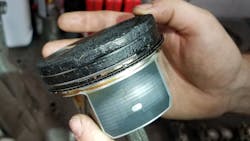
Carbon buildup in the combustion chambers, on valves, and even inside intake manifolds of internal combustion engines has been a source of reduced performance and other drivability issues for a long time. In recent years, the advent of cleaner-running engines, especially those with gasoline direct injection (GDI) has resulted in a somewhat different set of carbon deposit problems that require repair strategies that differ from those used formerly.
First of all, let us look at the source of carbon buildup inside engines.
The combustion chambers and exhaust valves of an old-style gasoline engine, operating with carburetor as a fuel source, tended to get caked with a hard, brittle coating of carbon over time. This was caused by a lack of precise fuel-air mixture, especially during engine warm-up and at low or idle speeds. Typically, the carburetor delivered a rich mixture under these conditions; the additional partially oxidized fuel dumped into the engine would, over time, cake up in hard layers, eventually causing restricted airflow and poor combustion.
When electronic fuel injection, later improved by the imposition of on-board diagnostics, became the norm in internal combustion engines, the era of rich mixtures gradually ended. Modern engines, especially those fueled by GDI, have a stoichiometric mixture (roughly 15:1 air/fuel mixture) at nearly all running speeds and nearly any operating temperature.
These more modern engines run considerably hotter than before; this is mostly due to a leaner fuel mixture as well as higher radiator thermostat settings. Elevated engine temperature causes the lubricating oil inside these engines to give off more fumes, oil vapors equal more contaminants. Additionally, lower tension piston rings allow more blow-by gases into the crankcase, potentially diluting the oil with unburned fuel and water vapor. The crankcase breather system must therefore be set up to vent a mixture of oil vapor, unburned fuel, and water vapor back into the intake manifold. This mixture, when heated up, turns into a sludgy or gummy residue, the modern version of old-style engine carbon buildup.
An additional source of unburned carbon coating on the intake side is engine oil that seeps past valve stem seals and coats valve heads and seats. Intake valves in GDI systems are not scoured by incoming atomized fuel. In older systems, this fuel flowed past intake valves used to keep them relatively clean of carbon deposits, but now valves get coated with unburned oil deposits.
Previously, the driver of a vehicle with carbon buildup in combustion areas often detected drivability issues early. Misfiring, rough running, or poor idle; the driver would bring a vehicle exhibiting such performance loss to a repair shop. Once carbon deposits were diagnosed as the issue, a technician could use the usual repair strategies to clean carbon from engines. Some techniques worked better than others: water poured through the carburetor and throttle body while the engine was running at speed could clean off carbon deposits. Alternatively, a variety of chemical solvents (top engine cleaner) available at the time, was poured into a running engine using the brake booster vacuum port on the intake manifold. The engine eventually stalled. More solvent was then poured in and allowed to soak the combustion chambers and valves overnight; upon restart the next day much of the carbon flaked off and blew out the tailpipe.
Technicians developed newer techniques to treat newer engines, which, as described earlier, show similar problems but with gummier, softer carbon deposits. Some methods, such as walnut shell blasting, require the engine to be partially disassembled. Removing the intake manifold allows the technician to blast off the carbon on valve stems and seat, combustion chambers, and inside the intake manifold. Even more radical remedies can include cylinder head removal and disassembly to clean off the carbon using scouring tools.
Advancements in chemical technology and the introduction of the ATS 3C Carbon Cleaning Removal System enables technicians to remove large carbon deposits without engine disassembly.
However, bear in mind that modern engine designs with electronic engine management and onboard diagnostics also feature adaptive systems.
Such systems detect small malfunctions and cleverly modify engine management to mask the gradual deterioration of engine performance due to carbon deposits.
An unintended consequence of this is that a driver remains unaware of impending problems until they become large enough so that the advanced adaptive system can no longer mask them.
This is why it is important to perform non-intrusive routine chemical carbon cleanings.
Drivers of modern engines with adaptive engine management must be trained to request routine decarbonization of the engine at set intervals before the carbon deposits become more difficult to remove. Variations in engine design, gasoline and oil quality, and driving style could make the recommended service interval variable, but experience so far seems to indicate that decarbonization at 30,000-mile intervals, before there are symptoms, is a worthy goal to safeguard against extreme and expensive carbon build-up on intake surfaces leading to very poor performance or complete breakdown.
Information provided by ATS Carbon Clean

